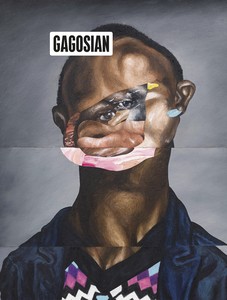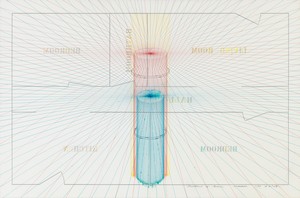
Now available
Gagosian Quarterly Fall 2019
The Fall 2019 issue of Gagosian Quarterly is now available, featuring a detail from Sinking (2019) by Nathaniel Mary Quinn on its cover.
Renowned for his paintings, drawings, and prints, as well as his innovative architectural constructions, Arakawa was one of the earliest practitioners of the international conceptual art movement of the 1960s. After moving to New York from Japan in 1961, he produced diagrammatic paintings, drawings, and other conceptual works that employed systems of words and signs to both highlight and investigate the mechanics of human perception and knowledge. In 1962 Arakawa met the American poet Madeline Gins, with whom he developed a personal and creative partnership. Together they expanded Arakawa’s painting practice into an important series entitled The Mechanism of Meaning, a suite of eighty canvases that explored the workings of human consciousness. The Mechanism of Meaning exists in two versions, exhibited in their entirety by the Sezon Museum of Modern Art, Karuizawa, Japan, in 1988 and the Guggenheim Museum, New York, in 1997. In the 1990s Arakawa and Gins developed the theory of “procedural architecture” which proposes using the built form as a way to investigate and transform the relationship between body and environment. Through architecture specifically, they endeavored to “learn how not to die.” Terming this concept “reversible destiny,” they believed firmly in the capacity of their architectural works to positively influence the personal well-being and longevity of those who lived within them. Arakawa and Gins dedicated the remainder of their lives to seeing these ideas integrated into architectural theory and contemporary building design.
Arakawa was born in 1936 in Nagoya, Japan, and died in 2010 in New York. He attended the Musashino Art University in Tokyo. His work has been exhibited extensively throughout North America, Western Europe, and Japan. Major retrospectives include Constructing the Perceiver—Arakawa: Experimental Works, National Museum of Modern Art, Tokyo (1991), and Reversible Destiny— Arakawa/Gins, Guggenheim Museum, New York (1997). His work is featured in institutional collections worldwide, including the Metropolitan Museum of Art, New York; Museum of Modern Art, New York; Centre Pompidou, Paris; Sezon Museum of Modern Art, Karuizawa, Japan; and National Museum of Modern Art, Tokyo, as well as in numerous private and corporate collections. Arakawa represented Japan in the 35th Biennale di Venezia, Venice in 1970 and was included in Documenta IV (1968) and Documenta VI (1977).

The Fall 2019 issue of Gagosian Quarterly is now available, featuring a detail from Sinking (2019) by Nathaniel Mary Quinn on its cover.
The exhibition Arakawa: Diagrams for the Imagination receives a closer look by Gagosian director Ealan Wingate. In this video, he discusses the artist’s arrival in New York and examines the importance of maps and language in Arakawa’s work.

Mary Ann Caws reflects on the centrality of perception and imagination in Arakawa’s art, from his early diagrammatic paintings to his later architectural investigations with Madeline Gins.

The influential work of the Japanese-born artist Arakawa—who forged prescient and crucial links between Dadaism, abstract art, Minimalism, conceptual art, Pop art, and more—explored by David Colman.